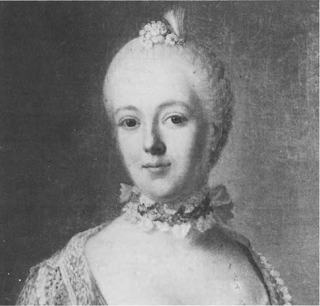Isabelle de Charrière
Isabelle de Charrière ( Belle van Zuylen ) (* October 20, 1740 in Utrecht, † December 27, 1805 Colombier ) was a Dutch -Swiss novelist ( French-speaking).
Life and work
Isabelle de Charrière was born on 20 October 1740 as "Isabella Agneta Elisabeth van Tuyll van Serooskerken " on Slot Zuylen Utrecht and of governesses from French-speaking Switzerland educated ( 1748-1753 ), which is why they mastered the French language fluently soon.
In the years after 1760 was David -Louis de Constant d' Hermenches her mentor. In 1762 her first novel Le Noble was published in French. A year later, she met James Boswell know that for her hand stopped later ( 1766 ). In London ( 1767) Isabelle David Hume had met. She married after she had rejected a large number of applicants, on 17 February 1771 coming from Switzerland educators of their brothers, Charles- Emmanuel de Charrière. In 1771 the couple moved to Colombier, where it occupied the property Le Pontet. During a stay in Paris on the trip they received drawing lessons from Maurice Quentin de la Tour. There began between Isabelle a friendship with the local pastor David de Chaillet and with Pierre -Alexandre du Peyrou. With the latter, managed large parts of the estate of Jean -Jacques Rousseau, Rousseau took care of the devotee 1789, the publication of Rousseau's " Confessions ".
Already in 1784 published her novels Lettres Neuchâteloises and Mistress Henley, a rich number of other publications, some of which were translated by Ludwig Ferdinand Huber, who lived with his future wife, Therese Huber several years in the nearby Bôle in the German language. 1787 she met Benjamin Constant. This relationship ended for the time being, as Germaine de Stael Constant is turned, but both remained further in close personal and epistolary contact.
Isabelle de Charrière died on the night of 26 and 27 December 1805 in Le Pontet.
Importance and influence
Isabelle de Charrière has great significance for the reception of German classicism in the French -speaking world. Its importance as a writer and letter writer for the time of the late Enlightenment and the French Revolution is now examined particularly in the English, American and French feminist research. She stood in corresponded contact with eminent personalities of her time and knew about their own literary activity also as an intermediary between the German and the French culture. Despite all the personal differences it was therefore admired by Germaine de Stael about, even if Isabelle de Charrière was the emerging romantic school of German literature and not get anything against Madame de Stael a defense for Rousseau's widow Thérèse Levasseur (1721-1801) published.
She tried to encourage young regional talent and to keep on writing. This was first discovered by her Henriette L' Hardy and later the living as the daughter of the local pastor Jonas de Gélieu in Colombier Isabelle de Gélieu. With this, she published in 1797 a French translation of the novel "Art and Nature" by Elizabeth Inchbald.
Trivia
- The asteroid with the No. 9604 Bellevanzuylen was named after her in 1991.
- In Utrecht was the construction of a skyscraper, the tallest building in the Netherlands, planned, which should be named " Belle van Zuylen ".
Works
- Oeuvres complètes. Éd. J -D. Candaux, C. P. Courtney, P. Dubois, S. Dubois, P. Thompson, J. Vercruysse, DM Wood G. A. van Oorschot, Amsterdam 1979-1984, Vol 10 ISBN 9789028205000
- Belle van Zuylen van Composities. 1 Airs et Romances, 2 minuets 3 Piano Sonatas. Geredigeerd en inge sorry door Marius Flothuis. Amsterdam, Donemus, 1983.
- Regained handwriting: Victoire ou la vertu sans bruit. Edited by Magdalene Heuser. In: Editio. International Yearbook for Science Edition. 11 (1997 ), pp. 178-204.
- Early Writings. New stuff from Dutch archives. Éd. Kees van Strien, Leuven, Éditions Peeters, 2005. ISBN 978-90-429-1646-3
- Correspondences et textes inédits. Éd. Guillemette Samson, J -D. Candaux, J. Vercruysse et D. Wood. Paris, Honoré Champion, 2006. ISBN 978-2-7453-1310-2
Expenditure
- The advantages of the old nobility. A story from the French by Johann Lorenz Benzlers. Lemgo, in Meyer's Bookstore, 1772.
- Cecilie and Kalliste, or letters from Lausanne. After the French by Frederick Menzel. Bayreuth, publisher of Zeitungsdruckerey, 1792.
- Swiss sense. Comedy in three acts. After the French manuscript: L' Emigré by the wife of C ***, translated by the editor of the peace preliminaries ( = Ludwig Ferdinand Huber). Berlin, Vossische bookstore in 1794.
- The Desolate. Comedy in one act. After the French manuscript of the author of Swiss sense, translated by the editor of the peace preliminaries. Berlin, Vossische bookstore in 1794.
- Letters from the papers of some emigrants. From the author of the comedy Swiss sense, translated and edited by LF Huber. In: Peace preliminaries bd bd 3 and 4 in 1794. Reprint: Alphons and Germaine: or letters from the papers of some emigrants. Berlin, Vossische bookstore. 1795.
- Reprint: The ruined castle. After the French of the Abbé de la Tour. Free editable. Leipzig, C. G. Weigel, 1801.
Editions
- Three wives. From the French by Ludwig Ferdinand Huber and Manfred Hinz (Ed.). [New translated p 143-202, p 203-236 epilogue ]. Passau, Verlag Karl Stutz. 2009, ISBN 978-3-88849-073-6









